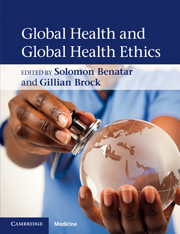Book contents
- Frontmatter
- Contents
- List of contributors
- Introduction
- Section 1 Global health, definitions and descriptions
- Section 2 Global health ethics, responsibilities and justice: some central issues
- Section 3 Analyzing some reasons for poor health
- Section 4 Shaping the future
- 20 The Health Impact Fund: how to make new medicines accessible to all
- 21 Biotechnology and global health
- 22 Food security and global health
- 23 International taxation
- 24 Global health research: changing the agenda
- 25 Justice and research in developing countries
- 26 Values in global health governance
- 27 Poverty, distance and two dimensions of ethics
- 28 Teaching global health ethics
- 29 Towards a new common sense: the need for new paradigms of global health
- Index
- References
21 - Biotechnology and global health
Published online by Cambridge University Press: 01 March 2011
- Frontmatter
- Contents
- List of contributors
- Introduction
- Section 1 Global health, definitions and descriptions
- Section 2 Global health ethics, responsibilities and justice: some central issues
- Section 3 Analyzing some reasons for poor health
- Section 4 Shaping the future
- 20 The Health Impact Fund: how to make new medicines accessible to all
- 21 Biotechnology and global health
- 22 Food security and global health
- 23 International taxation
- 24 Global health research: changing the agenda
- 25 Justice and research in developing countries
- 26 Values in global health governance
- 27 Poverty, distance and two dimensions of ethics
- 28 Teaching global health ethics
- 29 Towards a new common sense: the need for new paradigms of global health
- Index
- References
Summary
Introduction
As the branch of science concerned with the application of biological processes for industrial, health and agricultural purposes, biotechnology joins nutritional science and biomedical engineering as a major application of science and technology for improving human health. But every new technology poses ethical issues. What are the current and potential benefits of the technology, and what are the risks? How can the profit motive be harnessed for technology development, while keeping humanitarian technologies affordable? How much should be invested in developing the technology, and how much in scaling up existing techniques?
This chapter shines a light on these ethical issues by describing how biotechnology might be employed to improve global health, and discussing factors to consider when thinking about risks and implementation. We begin with the example of smallpox and vaccines, and continue on to biotechnologies for applications such as diagnostics, micronutrients, clean water, bioremediation, drug delivery systems and therapies. (It is important to note that the potential longer-term health applications of biotechnology extend far beyond the current and near-term applications which are the focus of this chapter.)
The eradication of smallpox through the advent of vaccination is one of the great success stories of modern medicine and public health (Barquet & Domingo, 1997; Andre, 2002). Although the process of exposing a healthy person to infected materials, known as variolation, was commonly practiced in China, India and Turkey before the mid-fifteenth century, a significant proportion of those treated died from serious infection.
- Type
- Chapter
- Information
- Global Health and Global Health Ethics , pp. 251 - 260Publisher: Cambridge University PressPrint publication year: 2011



